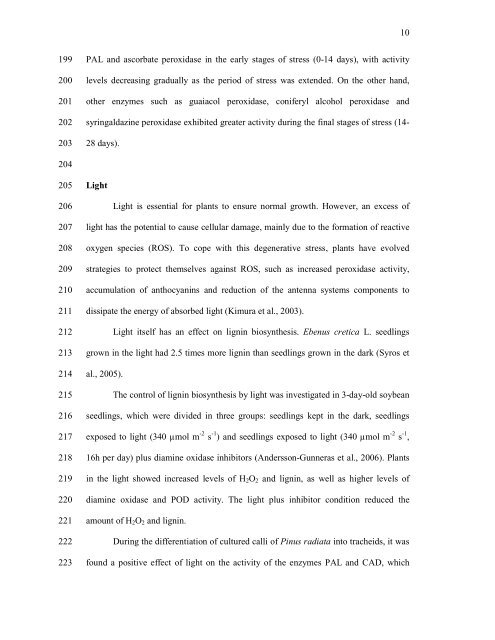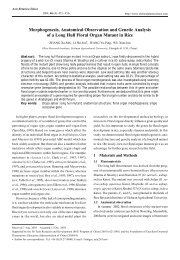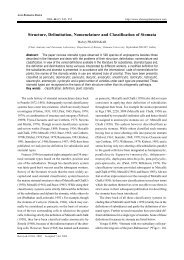Abiotic and biotic stresses and changes in the lignin ... - ResearchGate
Abiotic and biotic stresses and changes in the lignin ... - ResearchGate
Abiotic and biotic stresses and changes in the lignin ... - ResearchGate
Create successful ePaper yourself
Turn your PDF publications into a flip-book with our unique Google optimized e-Paper software.
10<br />
199<br />
200<br />
201<br />
202<br />
203<br />
PAL <strong>and</strong> ascorbate peroxidase <strong>in</strong> <strong>the</strong> early stages of stress (0-14 days), with activity<br />
levels decreas<strong>in</strong>g gradually as <strong>the</strong> period of stress was extended. On <strong>the</strong> o<strong>the</strong>r h<strong>and</strong>,<br />
o<strong>the</strong>r enzymes such as guaiacol peroxidase, coniferyl alcohol peroxidase <strong>and</strong><br />
syr<strong>in</strong>galdaz<strong>in</strong>e peroxidase exhibited greater activity dur<strong>in</strong>g <strong>the</strong> f<strong>in</strong>al stages of stress (14-<br />
28 days).<br />
204<br />
205<br />
Light<br />
206<br />
207<br />
208<br />
209<br />
210<br />
211<br />
212<br />
213<br />
214<br />
215<br />
216<br />
217<br />
218<br />
219<br />
220<br />
221<br />
222<br />
223<br />
Light is essential for plants to ensure normal growth. However, an excess of<br />
light has <strong>the</strong> potential to cause cellular damage, ma<strong>in</strong>ly due to <strong>the</strong> formation of reactive<br />
oxygen species (ROS). To cope with this degenerative stress, plants have evolved<br />
strategies to protect <strong>the</strong>mselves aga<strong>in</strong>st ROS, such as <strong>in</strong>creased peroxidase activity,<br />
accumulation of anthocyan<strong>in</strong>s <strong>and</strong> reduction of <strong>the</strong> antenna systems components to<br />
dissipate <strong>the</strong> energy of absorbed light (Kimura et al., 2003).<br />
Light itself has an effect on lign<strong>in</strong> biosyn<strong>the</strong>sis. Ebenus cretica L. seedl<strong>in</strong>gs<br />
grown <strong>in</strong> <strong>the</strong> light had 2.5 times more lign<strong>in</strong> than seedl<strong>in</strong>gs grown <strong>in</strong> <strong>the</strong> dark (Syros et<br />
al., 2005).<br />
The control of lign<strong>in</strong> biosyn<strong>the</strong>sis by light was <strong>in</strong>vestigated <strong>in</strong> 3-day-old soybean<br />
seedl<strong>in</strong>gs, which were divided <strong>in</strong> three groups: seedl<strong>in</strong>gs kept <strong>in</strong> <strong>the</strong> dark, seedl<strong>in</strong>gs<br />
exposed to light (340 µmol m -2 s -1 ) <strong>and</strong> seedl<strong>in</strong>gs exposed to light (340 µmol m -2 s -1 ,<br />
16h per day) plus diam<strong>in</strong>e oxidase <strong>in</strong>hibitors (Andersson-Gunneras et al., 2006). Plants<br />
<strong>in</strong> <strong>the</strong> light showed <strong>in</strong>creased levels of H 2 O 2 <strong>and</strong> lign<strong>in</strong>, as well as higher levels of<br />
diam<strong>in</strong>e oxidase <strong>and</strong> POD activity. The light plus <strong>in</strong>hibitor condition reduced <strong>the</strong><br />
amount of H 2 O 2 <strong>and</strong> lign<strong>in</strong>.<br />
Dur<strong>in</strong>g <strong>the</strong> differentiation of cultured calli of P<strong>in</strong>us radiata <strong>in</strong>to tracheids, it was<br />
found a positive effect of light on <strong>the</strong> activity of <strong>the</strong> enzymes PAL <strong>and</strong> CAD, which







